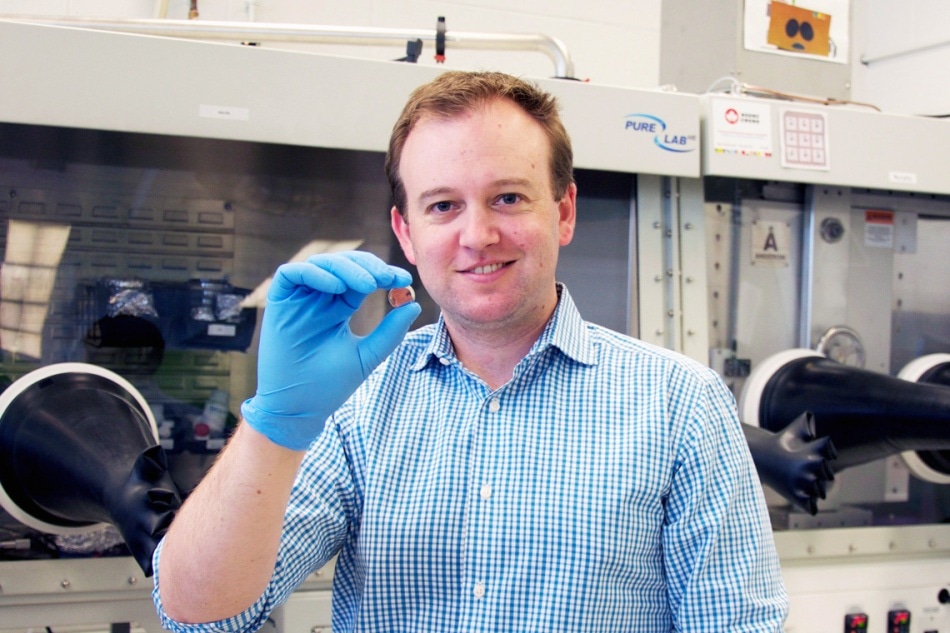Aug 4 2016
 Dwight Seferos, holding the nickel-sized prototype, hopes the team's breakthrough could lay the groundwork for metal-free batteries to support the next wave of consumer electronics (photo by Diana Tyszko)
Dwight Seferos, holding the nickel-sized prototype, hopes the team's breakthrough could lay the groundwork for metal-free batteries to support the next wave of consumer electronics (photo by Diana Tyszko)
A battery capable of storing energy in a biologically-derived unit has been developed by a team of chemists from the University of Toronto (U of T), opening the door for cost-effective, environmentally friendly consumer electronics.
Unlike many commercial high-energy lithium-ion batteries available on the market, the cathode of the new battery is flavin, derived from vitamin B2. The cathode is the component of a battery that releases the stored electricity when coupled to a device.
We've been looking to nature for a while to find complex molecules for use in a number of consumer electronics applications. When you take something made by nature that is already complex, you end up spending less time making new material.
Dwight Seferos, Associate Professor, U of T
The researchers described their discovery in a paper published in the July issue of Advanced Functional Materials.
Background Battery Basics
To understand the significance of the discovery, it is essential to know the three basic components of the modern batteries:
- A positive terminal is a metal component that makes contact with devices to power them and is coupled to a cathode within the battery casing
- A negative terminal coupled to an anode within the battery casing
- An electrolyte solution that allows ions to move between the anode and cathode electrodes
Connecting a battery to devices that require power, such as camera, phone, or iPod make the electrons flow from the anode, which is the negatively charged electrode of the device that supplies current, to the device, subsequently into the cathode. Now, ions travel via the electrolyte solution for balancing the charge. The reverse process takes place when coupled to a charger.
The reaction at the anode generates electrons, which are absorbed by the reaction at the cathode while discharging. The resulting product is electricity.
Electricity will constantly be generated by the battery until the substance required for the reactions to take place is exhausted by one or both of the electrodes.
Organic Chemistry is Kind of Like Lego
Bio-derived battery components have been developed earlier. However, this is the first time bio-derived polymers, which are long-chain molecules, have been used for one of the electrodes. This new development essentially allows storing battery energy in a vitamin-created plastic, instead of expensive, hard to process, and environmentally harmful metals like cobalt.
Getting the right material evolved over time and definitely took some test reactions. In a lot of ways, it looked like this could have failed. It definitely took a lot of perseverance.
Tyler Schon, Doctoral Student, U of T
Schon, Seferos, and colleagues came across the material when exploring a range of long-chain polymers, pendant group polymers in particular, where the molecules are coupled to a 'backbone' chain of a long molecule.
“Organic chemistry is kind of like Lego,” he says. “You put things together in a certain order, but some things that look like they'll fit together on paper don't in reality. We tried a few approaches and the fifth one worked,” says Seferos.
Building a Better Power Pack
The researchers used vitamin B2 derived from genetically-modified fungi to create the material. To prepare the polymer, they linked two flavin units to the 'backbone' chain of a long molecule using a semi-synthetic process. This results in a high capacity and high voltage battery that is also eco-friendly, which is especially important owing to the increased adoption of the ‘Internet of Things’ to link people through portable battery-powered devices.
“It's a pretty safe, natural compound," Seferos adds. “If you wanted to, you could actually eat the source material it comes from.”
B2 can be oxidized and reduced, making it ideal for a lithium ion battery.
B2 can accept up to two electrons at a time. This makes it easy to take multiple charges and have a high capacity compared to a lot of other available molecules.
Tyler Schon, Doctoral Student, U of T
A Step to Greener Electronics
“It's been a lot of trial-and-error,” says Schon. “Now we're looking to design new variants that can be recharged again and again.”
Since the size of the current prototype is comparable to a hearing aid battery, the researchers believe that their achievement could pave the way for powerful, flexible, thin, and even transparent metal-free batteries for use in future electronics.